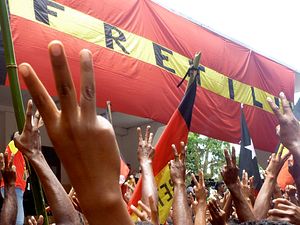It is estimated that around 390,000 people out of Timor-Leste’s 1.2 million population are Facebook users. That’s a relatively low number compared to the 15 million Facebook users among Australia’s 25 million population, but that is not to say that the 30 percent penetration of Facebook users in Timor-Leste is insignificant. That percentage is likely made up of the most significant demographic in Timor-Leste: young people.
A significant part of that group of young people, those born in 1999 and 2000, were eligible to vote for the first time in the 2017 parliamentary elections. Undoubtedly the complicated results of the 2017 election reflected a complicated voting landscape, which the arrival of this group contributed to. The lack of a clear majority government led to the 2018 parliamentary elections, which were conducted peacefully and demonstrated a successful exercise in democracy.
One key tool helping to further mature Timor-Leste’s democracy and increase the participation of Timorese voters in the political process is Facebook.
For a number of years, political parties in Timor-Leste have used closed groups in order to organize activities, and individuals have used their own profiles to promote their strong allegiance to a party. However, the emergence of more public, and more official, Facebook pages created a marked change in the use of the social media platform. For example, Fretilin created an official Facebook page just prior to the 2017 election campaigning period and it is the most established presence in that space. For Khunto and Partido Democratico (PD) it is notably more difficult to discern how “official” their pages are, which perhaps reflects a reliance still on the use of closed organizing groups for supporters.
Social media engagement through the official party pages was used to a limited extent to encourage physical participation in the election campaign. A post on Fretilin’s Facebook page contained the date and location for a range of activities, the most frequent being the comicio (rally), along with a series of dialogo (dialogue) — similar to a town hall discussion — and a specific set of dialogo juventude (youth dialogue), showing an effort to engage more closely with issues facing young people. Posts across all parties heavily encouraged people to vote, which was important considering the circumstances that led to the most recent election, and the dissatisfaction and lack of truthful information surrounding the circumstances of the demise of the 2017 parliament.
The Change for Progress Alliance, otherwise known as AMP, created a page for the 2018 election and in the last week of the campaign period grew from 19,543 likes to 25,045 likes, though the page pales in comparison to the 89,919 likes that Fretilin’s page had in the last days of the election. Yet AMP emerged victorious in the polls. Thus Facebook cannot yet be used as a valid tool to make prognostications on election outcomes in Timor-Leste, particularly due to the emergence of official coalitions in the last election, which made the outcome quite unpredictable.
There are also low user levels in Timor-Leste compared to established democracies such as the United States, or even in near neighboring countries such as Fiji. On the data alone, it does not appear that the digital revolution has occurred in Timor-Leste, though arguably it has started and is on its way. Social media does have exciting potential, particularly in a country where party allegiance is so widely promoted. Public social media accounts would provide an opportunity to assess what another party is doing, and the major issues they are highlighting, without attending a rally and giving away your allegiance. It would also be interesting to analyze the organic discussions occurring on election issues and undoubtedly opinions on political leaders.
The use of social media by political parties in the most recent parliamentary elections of 2017 and 2018 paints a fascinating picture of the colorful, lively style of political campaigning in Timor-Leste. The elections of 2018 were the first opportunity to really look at the public-facing use of social media by political parties in Timor-Leste and are helpful to gain an understanding of what influences permeate the political landscape.
Corinda Hollis is completing a Bachelor of International Security Studies at the Australian National University. She is currently working as a Political Affairs Officer at the Embassy of Timor-Leste. Hollis contributed to this article in her own personal capacity. The views expressed are her own and do not necessarily represent the views of the Government of Timor-Leste or associated institutions.

































